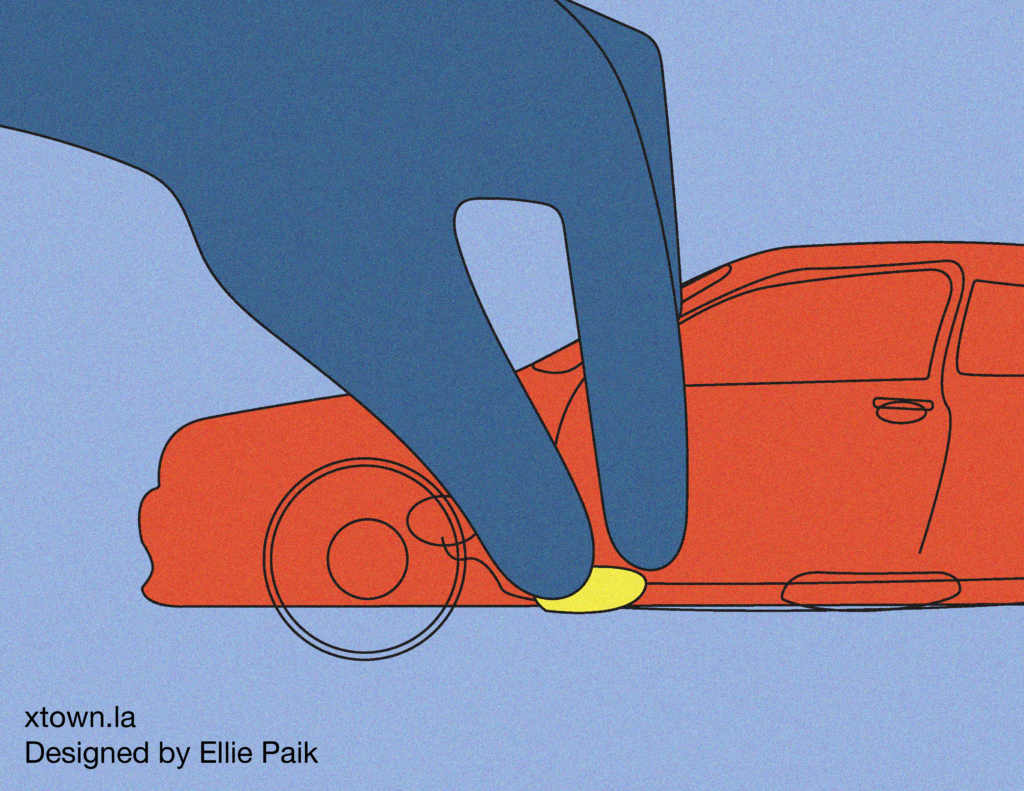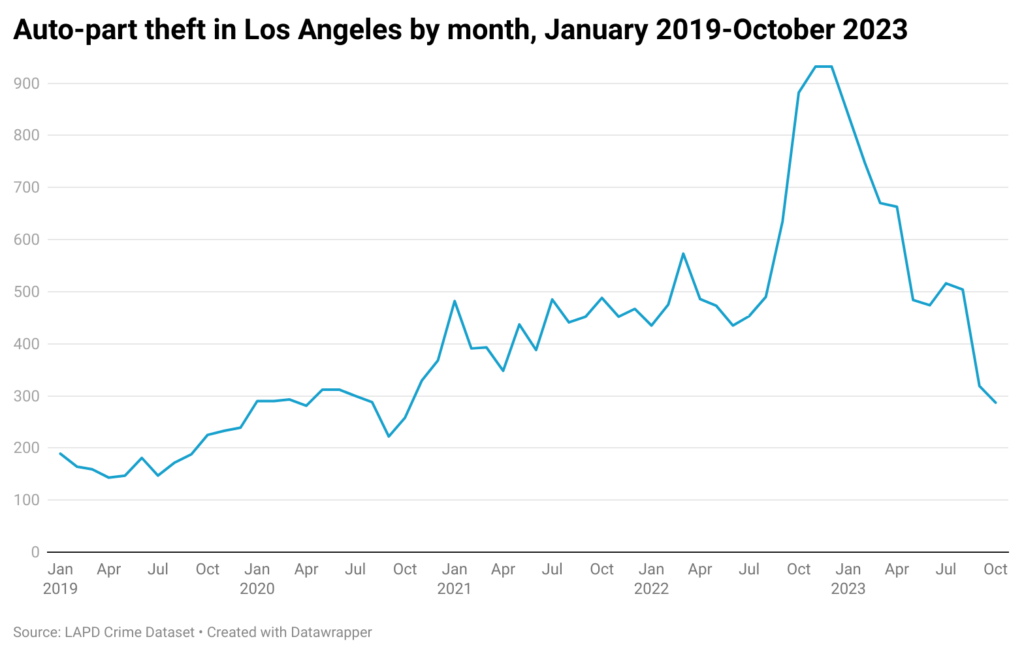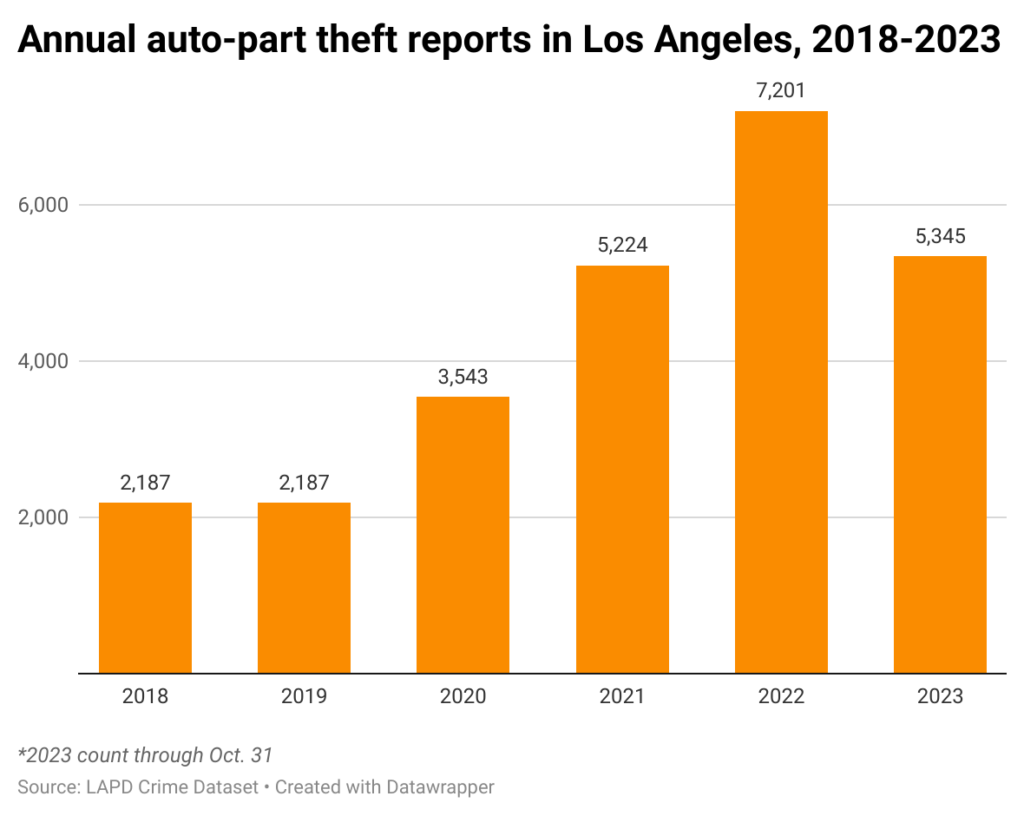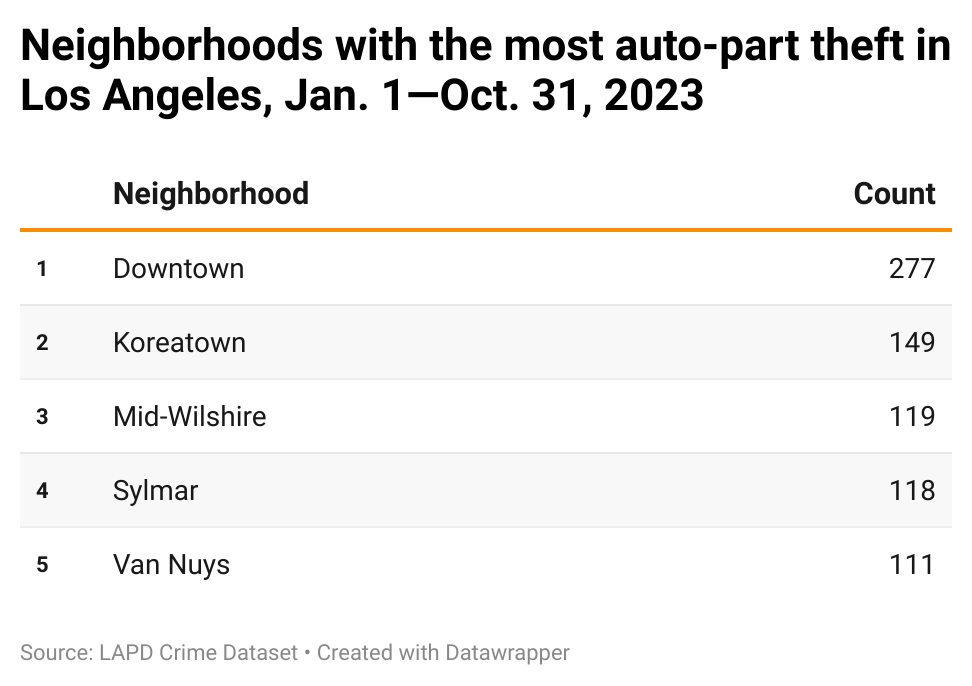Catalytic converter theft plummets in Los Angeles

At the start of 2023, Avi Margalit, who owns the South Los Angeles Prius repair shop Hybrid Fix, was getting daily calls about catalytic converter replacements. Toyota and Honda models were being frequently stolen because of the devices’ high concentrations of precious metals.
Demand was so high, Margalit said, that he often had to turn customers away because the parts that reduce harmful vehicle emissions were on back order for several months.
“At one point I was getting calls every day, but I wasn’t changing them every day because you can’t get the parts,” Margalit said.
[Get crime, housing and other stats about where you live with the Crosstown Neighborhood Newsletter]
As the end of the year approaches, Margalit said he now fields about one call a week requesting a catalytic converter replacement. For the last several months, converters for Priuses have been consistently in stock.
The situation at Margalit’s Exposition Park shop is emblematic of a dramatic change seen in Los Angeles and other cities. Reports of auto-part theft have taken a nosedive: After recording more than 800 incidents for four consecutive months starting last October, the count has stayed below 525 since May, according to publicly available Los Angeles Police Department data. Last month, there were just 287 reports of auto-part theft.

Money for metals
Multiple factors contribute to the downturn. They include economic shifts, as well as heightened attention to the matter from law enforcement and legislators.
“I’m glad to see those reductions,” said Lt. Klaus Edgell of the LAPD’s Commercial Crimes Division. Edgell, who also works on the multi-agency Task Force for Regional Auto Theft Prevention (TRAP), added, “A lot of it is just the community working with law enforcement, partnering up, educating themselves, doing their part to make sure that they keep their vehicles as safe as possible.”
In 2018 and 2019, there were commonly 150 to 200 monthly auto-part theft reports in the city (the count includes occasional thefts of air bags, headlights or other vehicle components that can be resold). The figure soared during the pandemic, with thieves often working in crews and becoming adept at cutting the device from under a car in less than a minute. It frequently costs more than $2,000 to get a replacement.

Unscrupulous middle men would frequently buy the devices, and then remove and melt down the precious metals. The decrease in auto-part theft mirrors an overall drop in the prices of rhodium and palladium, according to mineral trading site MoneyMetals.
Rhodium, which fetched $942 per gram in March 2021, now sells at $143 per gram. Palladium went for $103 per gram in March 2022, but the price is now about $34.
New laws
Catalytic converters are stolen in neighborhoods across Los Angeles, but car-filled Downtown gets hit the hardest. From Jan. 1–Oct. 31 this year, there were 277 reports in the community. The neighborhood with the next-highest count is Koreatown (149).

More than half of all thefts in the first 10 months of 2023 took place while a vehicle was parked on a street, according to police data.

Los Angeles is not the only place where catalytic converter theft is tumbling. The average number of devices stolen each month across the country dropped by half from 2022 to 2023, according to data from the National Insurance Crime Bureau.
Insurance company State Farm last month also reported that it has seen a steep decline. The company said that in the first six months of 2023, it received 14,500 claims for catalytic converter theft. That is down from more than 23,000 claims in the same period last year.
Edgell believes that news stories about catalytic converter theft, and ensuing public education campaigns, have also helped to drive down thefts.
Then there are preventative efforts. The LAPD and TRAP have encouraged device etching, which involves inscribing a vehicle identification number on a catalytic converter to make it traceable. The agencies regularly hold etching events across the region.
Elected officials have also enacted legislation to crack down on the practice. In September 2022, Gov. Gavin Newsom signed two state laws that target buyers of stolen catalytic converters. Those who purchase a device are now required to have documentation ascertaining the devices were not illegally removed or sold.
In April, the Los Angeles City Council passed an ordinance that allows police to arrest someone in possession of a catalytic converter not related to a vehicle.
Yet another state law was signed last month, with Newsom giving his stamp to an Assembly Bill that, among other things, makes it a misdemeanor to remove or alter the vehicle identification number from a catalytic converter.
How we did it: We examined publicly available crime data from the Los Angeles Police Department from Jan. 1, 2010–Oct. 31, 2023. Learn more about our data here.
LAPD data only reflects crimes that are reported to the department, not how many crimes actually occurred. In making our calculations, we rely on the data the LAPD makes publicly available. LAPD may update past crime reports with new information, or recategorize past reports. Those revised reports do not always automatically become part of the public database.
Have questions about our data or want to know more? Write to us at askus@xtown.la.






